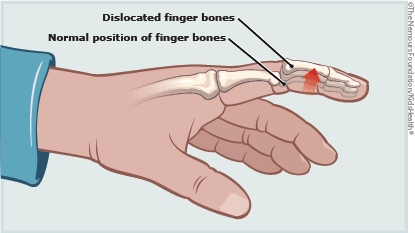A dislocated finger happens when the bones of a finger slip out of place. It's treated by placing the finger in a splint or taping the injured finger to the neighboring finger ("buddy taping") with padding in between. Buddy taping usually is needed for a few days to a few weeks while the injury heals. Most kids who dislocate a finger can gradually return to their normal activities. The finger may feel stiff for a while.

For swelling:
- For the next few days, put a cold pack or plastic bag of ice wrapped in a towel on the finger for 15–20 minutes three or four times a day. Do not place ice directly on the skin.
- Help your child keep the hand raised above heart level as often as possible. Try propping it up with pillows.
For pain:
If your child is uncomfortable, a pain medicine can help. If the health care provider says it's OK, give acetaminophen (such as Tylenol® or a store brand) OR ibuprofen (such as Advil®, Motrin®, or a store brand) exactly as directed. Don't give ibuprofen to babies under 6 months old.
Splint or tape care:
- If your child has a splint, follow your health care provider's instructions for taking care of it. Do not try to remove it or adjust it unless your health care provider told you to do so.
- If your child has buddy tape, follow the directions for when and how to remove the tape and replace it, especially if it gets wet or dirty. Remember to put something soft between the fingers like cotton, felt, or foam padding to prevent them from rubbing. Be sure not to wrap the tape too tightly.
- Have your child use a hand sanitizer to clean their hands except for when they're visibly dirty and need regular handwashing.
- If your health care provider recommended hand or finger exercises, your child should do them as instructed. These can help prevent the finger from feeling stiff.
Follow-up:
- Schedule a follow-up visit with the orthopedic doctor (bone specialist) as directed.
- Ask your health care provider when it's OK for your child to return to sports. They might recommend protective hand gear or taping for sports play.

How can fingers get dislocated? A finger can dislocate from a fall, blow, or sports injury, especially if it's bent back or jammed.
Can a dislocated finger happen again? Yes. A joint that dislocated once is more likely to dislocate again.




